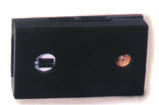Park Smart
Ever find yourself in pursuit of a parking spot? No doubt all motorists have at times found themselves searching level after garage level for the sanctity of an open space. Advanced sensor technology to improve the mobility of robots has been applied to precisely guide a driver to a free space.
The Parking Garage Automation System (PGAS) is based on Robot sensorSkinTM, a technology advanced by Merritt Systems, Inc., (MSI) of Oviedo, Florida. This technology was developed under a NASA Small Business Innovation Research (SBIR) contract awarded by the John F. Kennedy Space Center. NASA needed to enhance robots that worked in constrained, hazardous, or dynamic environments--conditions found in Space Shuttle operations, for example. MSI teamed with NASA to create a system that contains smartSensor™ modules and flexible printed circuit board skin. The Robot sensorSkin™ was originally crafted to be cut to fit, shaped, and installed on a variety of robot manipulator arms to increase their use near critical flight hardware. As a result, robots could better detect and steer clear of obstacles in their path.
In one application, the sensorSkin™ technology was used on a NASA prototype payload inspection and processing automaton, a long-reach serpentine inspection robot. This preflight inspection and verification robot for Shuttle payloads was outfitted with a skin of non-contact proximity, ultrasonic, and infrared smartSensor™.
This state-of-the-art sensor system work was adapted and applied by MSI to various commercial applications. For the PGAS, this smartSensor™ network can be installed around and within public parking garages. Once in place, these sensors guide a motorist to an open facility, and once the driver has entered, to an available parking space. The sensors use noninvasive, reflective-ultrasonic technology for high accuracy, high reliability, and low maintenance. Employed as a network, the sensors are connected to a garage computer, which in turn, is tied to outdoor smart parking signs via radio-frequency modem links. These signs can first signal to customers what garages have available spaces. Inside the garage, additional smart routing signs mounted overhead or on poles in front of each row of parking spots guide the motorists to any open parking slots.
Many public parking garages employ devices that only count cars entering a lot, not exiting. Therefore, garage operations typically don't know how many locations are vacant at any given moment. However, the PGAS offers parking lane vehicle counting with accurate parking area occupancy reporting. Armed with such knowledge, garage operators can realize increased revenue by keeping parking areas completely utilized.
Thanks to its modular design, the PGAS can be quickly and easily installed at a modest cost, within a new or retrofit setting. It requires no structural modifications to existing concrete construction. An added security feature is a license plate recognition system. This function can automatically read entering and exiting vehicle license plate numbers, logging this information into a computer.
Ronald Remus, CEO/president of MSI, explains that the SBIR commercialization of the company's technology is proving to be extremely successful. MSI has participated in several major security and parking industry trade shows, showcasing their innovative sensor work. Significant interest has recently been raised by one major railroad group, eyeing the MSI technology to provide vehicle classification for rail cars. The purpose is to prevent accidents caused by having oversized rail cars traveling on the wrong track, resulting in accidents caused by the oversized rail cars colliding with bridges or tunnels.
sensorSkin™ and smartSensor™ are trademarks of Merritt Systems, Inc.

The PGAS can be installed around and within public parking garages to monitor available parking spaces.













